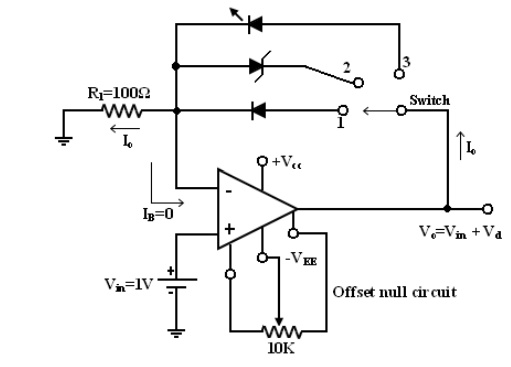Chapter: Linear Integrated Ciruits : Application of Op-Amp
Current to Voltage Converter (I-V)
Current to Voltage Converter (I
–V):

1. Open – loop gain a of the op-amp is very
large. V1»V2 @@@@
`1a
2. Input impedance of the op-amp is very high.
(i.e) the currents entering into the 2 input terminals is very small. IB=IB2
1. Sensitivity of the I – V
converter:
1.
The output voltage V0 = -RFIin.
2.
Hence the gain of this converter is equal to -RF.
The magnitude of the gain (i.e) is also called as sensitivity of I to V
converter.
3.
The amount of change in output volt ∆V0 for a given
change in the input current ∆Iin is decide by the sensitivity of I-V converter.
4.
By keeping RF
variable, it is possible to vary the sensitivity as per the
requirements.
2. Applications of V-I converter
with Floating Load:
1. Diode Match finder:

In some
applications, it is necessary to have matched diodes with equal voltage drops
at a particular value of diode current. The circuit can be used in finding
matched diodes and is obtained from fig (V-I converter with floating load) by
replacing RL with a diode. When the switch is in position 1: (Diode Match
Finder) Rectifierr diode (IN 4001) is placed in the f/b loop, the current
through this loop is set by input voltage Vin and Resistor R1 . For Vin = 1V
and R1 = 100Ω, the current through this
I0
= Vin/R1 = 1/100 = 10mA.
As long
as V0 and R1 constant, I0 will be constant. The Voltage
drop across the diode can be found either by measuring the volt across it or
o/p voltage. The output voltage is equal to (Vin + VD ) V0
= Vin + VD . To avoid an error in output voltage the op-amp should be
initially nulled. Thus the matched diodes can be found by connecting diodes one
after another in the feedback path and measuring voltage across them.
2. Zener diode Tester:
(When the
switch position 2)
when the
switch is in position 2, the circuit becomes a zener diode tester. The circuit
can be used to find the breakdown voltage of zener diodes. The zener current is
set at a constant value by Vin and R1. If this current is larger than the knee
current (IZK ) of the zener, the zenerr blocks (Vz )
volts.
For Ex:
IZK
= 1mA , VZ = 6.2V, Vin = 1v , R1 = 100Ω Since
the current through the zener is , I0 = Vin/R1
= 1/100 =10mA > IZK the voltage across the zener will be
approximately equal to 6.2V.
3. When the switch is in position 3: (LED)
The
circuit becomes a LED when the switch is in position 3. LED current is set at a
constant value by Vin and R1. LEDs can be tested for brightness one after
another at this current. Matched LEDs with equal brightness at a specific value
of current are useful as indicates and display devices in digital applications.
3. Applications of I – V
Converter:

One of
the most common use of the current to voltage converter is
1.
Digital to analog Converter (DAC)
2.
Sensing current through Photodetector. Such as
photocell, photodiodes and photovoltaic cells.
Photoconductive
devices produce a current that is proportional to an incident energy or light
(i.e) It can be used to detect the light.
4. DAC using I – V converter:
It shows
a combination of a DAC and current to voltage converter. The 8 digit binary
signal is the input to the DAC and V0 is the corresponding analog output of the
current to voltage converter. The outputu of the DAC is current I0, the value
of which depends on the logic state (0 or 1), of the binary inputs as indicated
by the following eqn.
This
means I0 is zero when all inputs are logic 0.
I0 is max
when all inputs are logic 1.
The
variations in I0 can be converted into a desired o/p voltage range by selecting
a proper value for RF. since, V0 = I0 RF
Where I0
is given by eqn (1). It is common to parallel RF with capacitance C to minimize
the overshoot. In the fig the o/p voltage of the current to voltage converter
is positive because the direction of input current I0 is opposite to
that in the basic I – V Converter.
Detecting current through
photosensitive devices:

Photocells,
photodiodes, photovoltaic cells give an output curren that depends on the
intensity of light and independent of the load. The current through this
devices can be converted to voltage by I – V converter and it can be used as a
measure of the amount of light. In this fig photocell is connected to the I – V
Converter. Photocell is a passive transducer, it requires an external dc
voltage(Vdc). The dc voltage can be eliminated if a photovoltaic cell is used
instead of a photocell. The Photovoltaic Cell is a semiconductor device that
converts the radiant energy to electrical power. It is a self generating
circuit because it doesnot require dc voltage externally. Ex of Photovoltaic
Cell : used in space applications and watches.
Related Topics